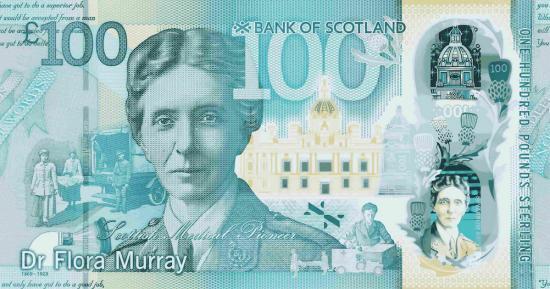Bank Of Scotland Unveils First £100 Polymer Note
6th July 2022

New green £100 polymer note features Scottish medical pioneer and suffragette Dr Flora Murray.
First polymer Bank of Scotland note to celebrate the contribution of a significant Scottish person.
Sought after FM and AA pre-fix notes will be auctioned in May with proceeds going to Mental Health UK and the Royal Free Charity, London.
Bank of Scotland has unveiled the design of its £100 polymer note, the first to celebrate the contribution of a significant Scottish person, with the new note entering circulation on 9th May 2022. The new £100 polymer note replaces the current cotton version - which is part of the ‘bridge series'- and will feature Dr Flora Murray, CBE (1869-1923), the Scottish medical pioneer and suffragette.
Dr Murray was a Scottish physician and a committed member of the Women's Social and Political Union suffragettes. Born in Murraythwaite, Dumfries Dr Murray qualified as a doctor in 1905. In 1912 she founded the Women’s Hospital for Children in London with her lifelong partner Dr Louisa Garrett Anderson, which provided healthcare for children of factory and shop workers in the area, who were low paid so accessing health care was difficult.
With the onset of World War I in 1914, Dr Murray and Dr Garrett Anderson founded the feminist organisation ‘Women’s Hospital Corps’ and opened two military hospitals in France, staffed entirely by female suffragettes. The hospitals were such a success that in 1915, the British war office provided them with premises in London, which they together transformed into the Endell Street Military Hospital, the first in the UK established for men by female medical professionals. The hospitals treated more than 50,000 seriously injured soldiers.
In 1917, Dr Murray was awarded a CBE for her work and medical efforts during the war, with her relationship with Louisa continuing until her death in 1923.
In addition to the colourful foil image of Dr Murray, the front of the new note portrays the Scottish novelist and poet Sir Walter Scott, alongside an image of The Mound in Edinburgh as the current £100 cotton note does today.
On the reverse of the first £100 green note is a striking portrait of Dr Murray, painted by Francis Dodd in 1921. It is accompanied by an image of female stretcher bearers outside Endell Street Hospital, London, bringing to life the significance Dr Murray had on the medical world and the fight for women’s rights.
The note has important security features which include an anti-counterfeit ‘window effect’ – transparent windows within The Mound frontage and a transparent vertical stripe – on the front of the note. Inside the vertical stripe is a multicoloured holographic foil strip which displays the image of Dr Murray, the bank’s logo, and ’£100.’ The foil also displays a ‘Northern Lights’ effect, with stars and colours resembling the phenomena appearing when the note is tilted.
In addition, as with the £5, £10, £20, and £50 polymer notes, the £100 note will have a tactile embossed feature, to aid the visually impaired.
Philip Grant, Chairman of the Scottish Executive Committee, Bank of Scotland, said: "Bank of Scotland has issued bank notes showcasing our country’s incredible history for more than 320 years and now we’re putting the contribution of exceptional Scottish people into the spotlight too.
“We are so proud that our new £100 polymer note commemorates the remarkable work of Dr Flora Murray who, alongside being a medical pioneer, spent her adult life fighting for women’s rights as a suffragette."
Caroline Clarke, Chief Executive of the Royal Free London NHS Foundation Trust, said: “As the first institution in Britain to train women in medicine, the Royal Free Hospital drew aspiring female doctors from across the globe; we’re immensely proud that the Bank of Scotland and the Royal Free Charity have worked together to give Flora her rightful place in the pantheon of British medical history.
“Almost a century since her death, Flora’s story is a reminder of the huge debt of gratitude we owe to those early agitators who refused to accept the limitations imposed by a society that didn’t believe women could or should be doctors, physicians and surgeons.
“Then and now, we embrace the pioneers, the innovators, and the game-changers.”
On 9th May 2022, Bank of Scotland auctioned off 94 sought-after notes with an ‘FM’ prefix to celebrate Flora using her initials, alongside ‘AA’ prefix notes, at Spink House, London. Monies raised from the auction goes to the Bank’s charity partner Mental Health UK and The Royal Free Charity, London. So far, auctions of polymer collectors’ notes have raised over £584,000 for charity.
